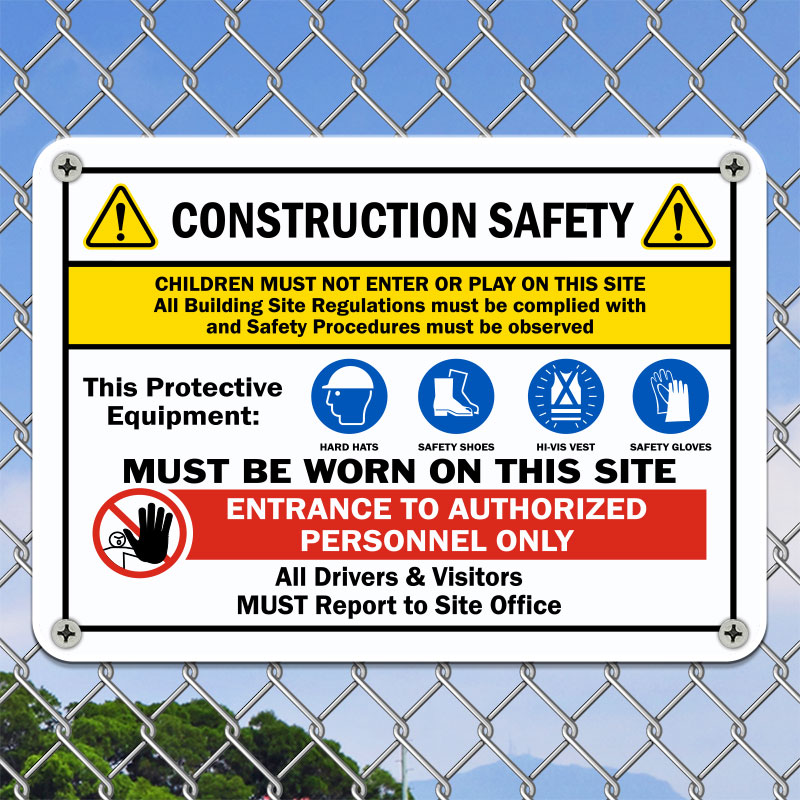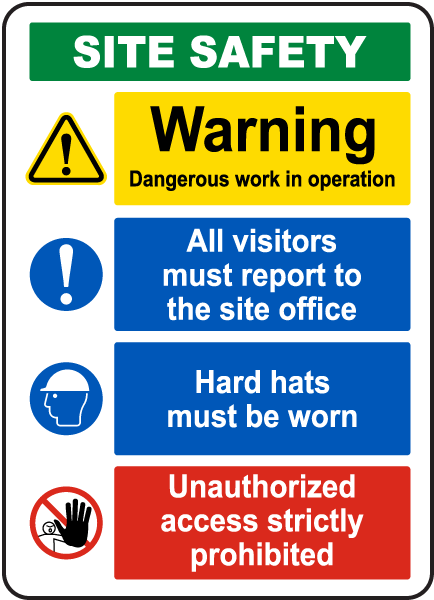A Thorough Introduction of Safety Signs and Their Capability in Connecting Hazards and Safety And Security Protocols
Safety indicators play a critical role in making sure understanding and conformity within different settings, from commercial setups to public spaces. The implications of these indications extend past plain conformity, motivating a better exam of their impact on workplace safety and threat mitigation.
Sorts Of Security Signs
In various environments, comprehending the sorts of security signs is important for guaranteeing the wellness of individuals. Safety and security indicators are classified mainly into four types: warning indications, mandatory indications, restriction indications, and emergency signs. Each kind serves an unique purpose in communicating vital info.
Indication, commonly yellow with black symbols, alert people to dangerous problems or possible risks, such as slippery floors or dropping items - Construction Safety Signs. These indicators are crucial for stopping mishaps by notifying individuals of dangers they might experience
Necessary indicators, blue and commonly round, suggest activities that should be required to guarantee safety, such as using personal protective devices or complying with details safety procedures. Compliance with these indicators is vital for maintaining a safe atmosphere.
Restriction indications, identified by a red circle with an angled line, indicate actions that are not permitted, such as "No Smoking" or "Do Not Go into." These indicators aid to avoid unsafe behaviors that could lead to injuries or mishaps.
Finally, emergency indicators, usually green, offer instructions for emergency situation leaves and safety equipment areas. Their clear exposure and instant acknowledgment are vital during emergencies, assisting in swift and secure evacuations.
Style Concepts of Safety Indications
Reliable design concepts of safety indications are important for guaranteeing that they share details quickly and clearly to people in different settings. The main purpose of a security indicator is to connect needed precautions and possible dangers, and this can be achieved through a series of vital design components.
First, color plays a vital role in sign recognition. Certain colors are globally linked with particular meanings; for instance, red suggests threat or prohibition, while green symbolizes security or permission - Construction Site Safety Signs.
Signs and symbols should be widely comprehended and quickly recognizable, usually using common pictograms that go beyond language barriers. The layout should be logical, positioning the most crucial information at eye level and avoiding mess to improve understanding. Sturdiness and climate resistance are important for exterior indications, making certain that they maintain presence and effectiveness under numerous conditions. By adhering to these layout principles, safety and security indicators can efficiently satisfy their objective of advertising recognition and security in diverse setups.
Capability and Interaction

Effective communication via safety signs counts on global signs and standard language. This technique decreases see here now misunderstandings and supplies clear guidance throughout diverse populaces, including those with varying degrees of language proficiency. For instance, an easy red circle with a diagonal line universally conveys "prohibition," while an environment-friendly square indicates safety or permitted actions.
Moreover, the critical positioning of safety and security check in high-risk areas additionally improves their performance. By placing indicators where they are most required, organizations can better stop accidents and advertise a society of safety and security. The assimilation of reflective materials and lit up signage also plays a crucial duty in ensuring exposure under different conditions, thus enhancing the value of these essential interaction devices in preserving a risk-free environment.

Governing Specifications and Compliance
Various governing standards regulate the style, placement, and upkeep of security indicators to ensure conformity and boost public safety and security. These requirements are established by numerous organizations, including the American National Requirement Institute (ANSI) and the Occupational Security and Wellness Management (OSHA), which provide guidelines on the requirements for materials, signs, and colors made use of in safety and security signage.
Compliance with these standards is critical as it not only promotes a secure environment but also decreases lawful responsibilities. Security indications have to be conspicuously put in locations where dangers exist and should be maintained in a legible and noticeable problem. Using standard signs and language aids in decreasing complication and makes sure that the intended message is efficiently communicated to a varied target market.
Additionally, companies are called for to conduct normal audits and inspections of click over here their safety signs to guarantee continuous compliance with suitable regulations. Failure to comply with these standards can lead to fines, increased threat of mishaps, and compromised safety for employees and the general public. Therefore, understanding and applying regulatory standards is important for any entity intending to prioritize safety via efficient interaction.
Value in Workplace Safety And Security
Identifying the vital function safety and security indicators play in workplace safety is necessary for cultivating a safe work atmosphere. Construction Signs. These signs offer as visual hints, properly communicating needed preventative measures and prospective threats to employees and visitors alike. By providing clear information, safety indicators decrease the danger of injuries and accidents, ensuring that employees understand their surroundings and the connected risks
The importance of safety and security indications extends beyond simple compliance with policies; they are essential to cultivating a safety-oriented society within the company. official statement Constant usage of well-designed indicators reinforces safety and security procedures, encouraging employees to embrace risk-free practices and stay alert. This aggressive technique not just protects individuals however likewise enhances total performance by minimizing downtime connected with crashes.
In addition, security indicators are important throughout emergency situations. Spending in quality safety and security signage is an essential element of any extensive office security technique, mirroring a company's dedication to focusing on the well-being of its workforce.
Conclusion

By adhering to these design principles, safety indications can properly meet their objective of advertising awareness and security in varied setups.
Identifying the essential function security indications play in work environment safety and security is crucial for cultivating a safe and secure work atmosphere. Spending in high quality safety and security signs is a basic element of any thorough office safety and security technique, reflecting a company's dedication to focusing on the health of its labor force.
In final thought, security signs play an essential role in sharing risks and safety protocols across various environments. Ultimately, the reliable application of security signs contributes significantly to risk decrease and the promotion of a culture of security within organizations.